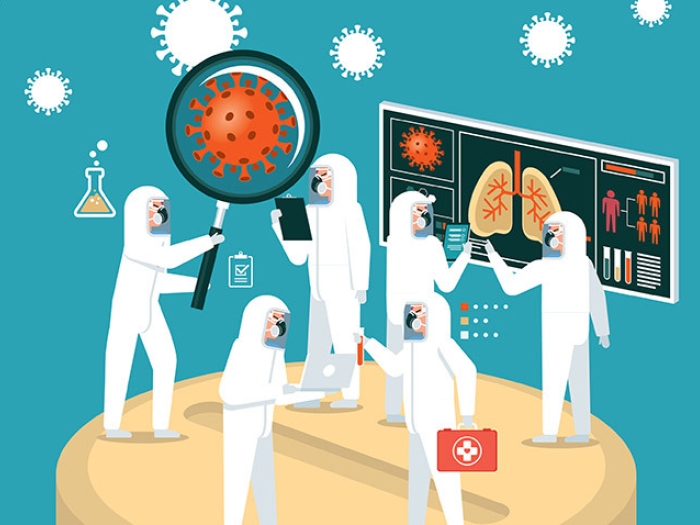Pulse oximeters more likely to be inaccurate in Black vs. white patients, with implications for COVID-19 and beyond.
1:45 PM
Author |

Thousands of times a day, doctors and nurses use a small device called a pulse oximeter—which fits on the end of a patient's finger to measure the percentage of oxygen in the blood—to help them make vital treatment decisions. However, a new study by Michigan Medicine researchers finds that the pulse oximeter may be less accurate in Black patients than in white patients.
"These results really surprised all of us," says Michael Sjoding, M.D., assistant professor of Internal Medicine in the Division of Pulmonary and Critical Care Medicine. As he and his colleagues cared for critically ill patients with COVID-19, a significant percentage of whom were Black, they noted a reoccurring discrepancy between readings from the pulse oximeter and a measurement from an arterial blood gas, which measures oxygen saturation directly through a blood test.
Using data from patients hospitalized at Michigan Medicine and an older dataset of patients hospitalized in multiple intensive care units across the country, the research team compared results from pulse oximeters and arterial blood gas measurements in patients who identified as either Black or white.
Like Podcasts? Add the Michigan Medicine News Break on iTunes or anywhere you listen to podcasts.
"We wanted to know: when the pulse oximeter is measuring between 92 and 96%, how often is the oxygen saturation actually less than 88% on arterial blood gas?" says Sjoding, adding that a reading of below 88% is generally where most physicians start to take notice and intervene.
Black patients were three times as likely to have a significant discrepancy in these readings. Twelve percent of the time, when Black patients had a pulse oximeter reading in this safe range, their actual saturation on an arterial blood gas was below 88%. In white patients, this discrepancy occurred 4% of the time. The study appears as a correspondence in the New England Journal of Medicine.
"Many studies have examined health disparities between white and Black patients, with most determining Black patients have worse outcomes than white patients. What these studies often lack are reasons to explain these differences," says study co-author Thomas Valley, M.D., assistant professor in the Division of Pulmonary and Critical Care Medicine in the Department of Internal Medicine at the University of Michigan. "Our findings may provide one key explanation."
The findings raise a number of important questions about the management of patients in the hospital. Sjoding notes that there has been a departure from using the more invasive arterial blood gas measurements in favor of the simpler, less invasive pulse oximeter to determine whether a patient is getting enough oxygen. Knowing that pulse oximeter readings may be inaccurate will "absolutely affect therapy," he says. "I was caring for critically ill patients in the Intensive Care Unit when I first ran this analysis. The next day I started to rethink all my management strategies."
The findings aren't entirely new, the team reports. A paper published in an anesthesia journal in 2005 also reported that skin pigmentation led to inaccuracy in pulse oximeter readings.
"At the time, these findings weren't considered significant enough to change practice," says Sjoding.
"I think we're going to have to be more cautious about whether Black patients are truly getting that amount of oxygen they need. We may need to pay more attention to arterial blood gas results to confirm that the patient is getting enough oxygen."
MORE FROM THE LAB: Subscribe to our weekly newsletter
Sjoding says longer term, device makers may need to make additional changes to ensure that all patients are getting an accurate reading. Inaccurate pulse oximeter readings could have implications for outpatient care as well, as most clinics rely on the measurements to determine treatment needs.
"We're concerned about patients who need supplemental oxygen at home, like patients with emphysema. Those patients can qualify for supplemental oxygen if their saturation is less than 88%," says Sjoding. "There's no reason to think that these findings wouldn't apply to patients in an outpatient clinic."
This study also included the following U-M researchers: Robert P. Dickson MD, Theodore J. Iwashyna MD, PhD, Steven E. Gay MD, and Thomas S. Valley MD, MSc.
Paper cited: "Racial bias in pulse oximetry measurement," New England Journal of Medicine. DOI: 10.1056/NEJMc2029240

Explore a variety of healthcare news & stories by visiting the Health Lab home page for more articles.

Department of Communication at Michigan Medicine
Want top health & research news weekly? Sign up for Health Lab’s newsletters today!





